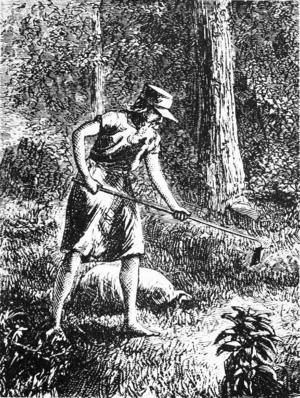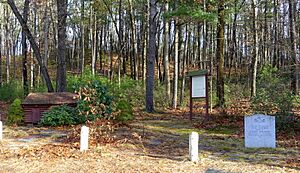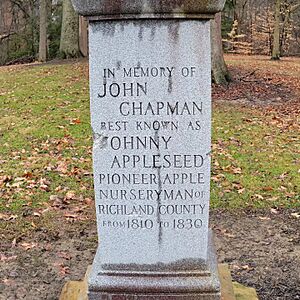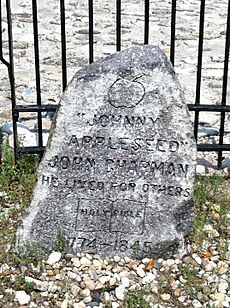Johnny Appleseed facts for kids
Quick facts for kids
Johnny Appleseed
|
|
|---|---|

An etching of Chapman from Harper's New Monthly Magazine (1871)
|
|
| Born |
John Chapman
September 26, 1774 |
| Died | March 18, 1845 (aged 70) Fort Wayne, Indiana, U.S.
|
| Occupation |
|
| Known for | Proliferation of orchards throughout the American frontier |
John Chapman (born September 26, 1774, died March 18, 1845) is much better known as Johnny Appleseed. He was an American pioneer who traveled across many states, planting apple seeds. He helped spread apple trees throughout Pennsylvania, Ohio, Indiana, Illinois, and parts of Ontario, Canada. People admired him for his kindness, generosity, and his efforts to protect nature. He became a famous American symbol even during his lifetime. Today, museums and historical places, like the Johnny Appleseed Museum in Urbana, Ohio, celebrate his story.
Contents
His Early Life
John Chapman was born on September 26, 1774, in Leominster, Massachusetts. He was the second child of Nathaniel and Elizabeth Chapman. Today, a special marker shows where he was born, and the street is named Johnny Appleseed Lane.
Sadly, John's mother, Elizabeth, passed away in 1776. His father, Nathaniel, later married Lucy Cooley in 1780. John had a sister named Persis Broom.
When John was 18, he traveled west with his 11-year-old half-brother, Nathaniel. They moved around a lot. Later, their father and the rest of the family joined them in Ohio in 1805. Nathaniel stayed to help their father with farming.
After John and his brother went their separate ways, John started learning how to grow fruit trees. He learned from a man named Mr. Crawford, who grew apples. This experience inspired John to dedicate his life to planting apple trees. By 1800, when he was 26, John was in Licking River, Ohio. He planted his first apple nursery on Isaac Stadden's farm in Licking County, Ohio. In 1806, he traveled by canoe down several rivers, carrying his precious apple seeds.
A Life of Planting and Travel
Johnny Appleseed was known for his special way of planting. Instead of just scattering seeds, he created small nurseries. These were like mini-orchards where young apple trees could grow safely. He built fences to protect them from animals. Then, he would leave the nurseries with a neighbor to care for them. He would return every year or two to check on his trees.
He started many nurseries in places like Brokenstraw Creek in Pennsylvania. He also planted many in the Mohican River area of north-central Ohio. Towns like Mansfield and Loudonville were part of his planting routes.
His Beliefs and Kindness
Johnny Appleseed was also a missionary for a Christian group called The New Church. He traveled around, sharing his spiritual beliefs and handing out books. In 1817, a report from England first mentioned his work as a missionary and apple planter.
He was known for his simple lifestyle. He often wore old clothes and walked barefoot, even in the snow. He sometimes wore a tin pot on his head, which he also used for cooking! Despite his simple appearance, he was a smart businessman. He bought land for his nurseries and owned many acres across different states. He chose to live simply, not because he had to, but because he wanted to.
Johnny Appleseed loved to tell stories to children. He also shared his spiritual ideas with adults. In return, people often offered him a place to sleep and a meal. He was a very kind person.
He cared deeply for all animals, even insects. One story tells how he put out his campfire to stop mosquitoes from flying into the flames. Another time, he found a bear and her cubs sleeping in a hollow log where he planned to camp. Instead of disturbing them, he moved his fire and slept outside in the snow. He even bought an injured horse to save it and later gave it to someone who promised to treat it well.
He also planted a plant called dogfennel. He thought it was a helpful medicine. However, this plant can spread very quickly and become hard to control.
Johnny Appleseed was a vegetarian later in his life. He never married, believing he would find his soulmate in Heaven if she didn't appear on Earth.
In 1819, he had a close call. He fell from a tree and got his neck caught in a branch. An eight-year-old boy named John White found him and quickly cut the tree down, saving his life.
His Final Years
There are different ideas about when Johnny Appleseed passed away. Many sources say he died in mid-1847, but Indiana newspapers reported his death date as March 18, 1845. The Goshen Democrat and the Fort Wayne Sentinel both printed notices about his death on that date.
The newspapers described him as about 70 years old. They mentioned his unique ways and simple clothes. He was known for his spiritual beliefs and for being a nurseryman. He had visited the Fort Wayne area for over 10 years. People believed he owned a good amount of land, but he chose to live very simply.
The exact location of his grave is also debated. Some believe it is at the Canterbury Green apartment complex in Fort Wayne, Indiana. This is where the Worth cabin, where he died, once stood.
However, Steven Fortriede, a historian, believes the correct grave site is in Johnny Appleseed Park in Fort Wayne. This park is next to Archer Park, which was once part of the Archer family farm. John Chapman's grave marker is located there. Records suggest he was buried "respectably" in the Archer cemetery.
In 1934, a special committee confirmed the grave in the Archer burying ground. They noted that men who attended his funeral in 1916 helped locate the spot.
His Lasting Impact
Johnny Appleseed left behind a large estate of over 1,200 acres of valuable nurseries. He owned land in Allen County, Indiana, and Mount Vernon, Ohio. However, a financial crisis in 1837 made his trees less valuable. After his death, some of his land was sold to pay taxes.
His story has inspired many artists and writers.
- In 1880, author Lydia Maria Child wrote a poem about him.
- Vachel Lindsay published poems about Johnny Appleseed in the 1920s.
- In 1933, Rosemary Carr Benét and Stephen Vincent Benét included him in their children's poetry book.
- Disney's 1948 film Melody Time features an animated story called "The Legend of Johnny Appleseed".
- In 1984, Jill and Michael Gallina created a musical about his life.
- In 2016, John Chapman appeared in Tracy Chevalier's historical novel At the Edge of the Orchard.
Festivals and Tributes
Many festivals celebrate Johnny Appleseed's legacy.
- The first recorded Johnny Appleseed Festival was held in 1968 in Lisbon, Ohio.
- Since 1975, the Johnny Appleseed Festival in Fort Wayne, Indiana, has been held every September. People dress in old-fashioned clothes and offer traditional food.
- Similar festivals take place in other towns like Sheffield, PA, and Apple Creek, OH.
Other tributes include:
- From 1962 to 1980, a high school sports league in Ohio was called the "Johnny Appleseed Conference".
- In 1966, the U.S. Postal Service released a five-cent stamp honoring him.
- The Fort Wayne TinCaps, a minor-league baseball team, are named after the tin hat Johnny Appleseed supposedly wore. Their mascot is named "Johnny".
- A memorial statue stands in Spring Grove Cemetery in Cincinnati, Ohio.
- A bronze statue of Chapman sits on a bench in Fort Wayne, Indiana, offering an apple.
- March 11 and September 26 are sometimes celebrated as Johnny Appleseed Day.
- Schools, like Johnny Appleseed Elementary School in his birthplace of Leominster, Massachusetts, are named after him.
- A large sculpture of Johnny Appleseed by Viktor Schreckengost is at Lakewood High School.
- Apple uses "John and Jane Appleseed" as generic names, inspired by him.
The Famous Apple Tree
Urbana University in Urbana, Ohio, has one of two Johnny Appleseed museums in the world. It displays artifacts and trees descended from those he planted. The museum helps people learn about his appreciation for education, nature, peace, and good character.
Supposedly, the only surviving tree planted by Johnny Appleseed grows on a farm in Nova, Ohio. This tree is often called the "Johnny Appleseed" variety. It ripens in September and is good for baking and applesauce. Nurseries offer young apple trees with parts from this famous tree grafted onto them. Johnny Appleseed himself had religious reasons for not using grafting. He preferred apples grown directly from seeds.
Images for kids
See also
 In Spanish: Johnny Appleseed para niños
In Spanish: Johnny Appleseed para niños







